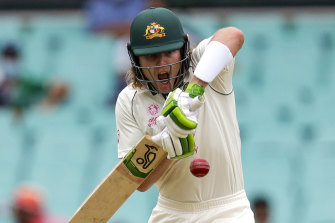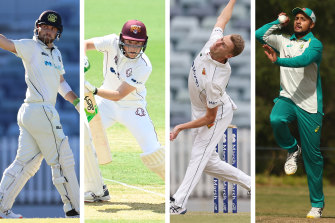Young talent crime: Where is Australia’s generation next?
In 2011, Cricket Australia high-performance boss Pat Howard asked then national talent boss Greg Chappell and the state talent managers to pick hypothetical squads for the following year’s Twenty20 World Cup, the 2013 Ashes and the 2015 one-day international World Cup.
Five players were nominated in all three squads: David Warner, Pat Cummins, James Pattinson and the Marsh brothers, Shaun and Mitchell. Steve Smith, Josh Hazlewood, Mitchell Starc, Usman Khawaja and the late Phillip Hughes had all been earmarked for long international careers.
Only Warner and Starc actually played in the three marquee events, but the core of that group has been prominent in Australia’s men’s team in the past decade.
If a similar exercise was conducted today for next year’s T20 World Cup, the 2023 ODI World Cup and 2025-26 Ashes at home, Cummins, 28, may well be the only player who selectors could confidently say would be picked for all three.
Cameron Green and Will Pucovski loom as 10-year Test players, but who else can that be said of for those aged 25 and under?
Chappell, who retired in 2019, and Steve Waugh have both asked questions about Cricket Australia’s development program, which can no longer claim to be the best in the world.
Will Pucovski is one of just four under-25 players who have a baggy green.Credit:AP
Cricketers generally do not peak until their late 20s, but world-class players tend to make their Test debuts well before then.
Pucovski, Green, Jhye Richardson and Matt Renshaw are the only under-25 players who have a baggy green. Compare this to the current generation: Cummins made his debut at age 18, Smith and Starc were 21, Hazlewood was 23, Khawaja, Marnus Labuschagne and Travis Head were 24, and Warner 25.
From the golden era of the 1990s and 2000s, Steve Waugh, Ricky Ponting, Shane Warne, Glenn McGrath, Matthew Hayden, Justin Langer and Jason Gillespie had all been given a taste of Test cricket by the age of 25, even if they did not immediately succeed.
Of the top 10 wicket takers and run scorers from last summer’s Sheffield Shield, only three – Green, Henry Hunt and Jake Doran – were under 25 by the end of the season.
When selectors name their extended 25-player squad for the Ashes this month, it would be a surprise if there was a player under 25 outside of Green, Pucovski and Richardson.
Given the current group has not been able to dominate world cricket, it does not bode well for the next wave.
The Herald and The Age spoke to several insiders in Australian cricket familiar with the country’s young talent. A common theme was that while there were few standouts, all had faith in the talent coming through, but acknowledged many players needed to get a move on.
This was evident in the names nominated for a hypothetical XI for the 2025-26 Ashes on home soil. Selection for the next series is difficult enough, let alone four years down the track, but of the incumbent team, the insiders could be confident of only Cummins, 28, and Labuschagne, 27, still being there.
Of the senior players, Smith and Hazlewood were given the best hope of holding on, although there must be considerable doubt given they will be 36 and 34 respectively.
In the batting ranks, those put forward by insiders – such as Queensland’s Bryce Street (23), South Australia’s Hunt (24), NSW’s Jason Sangha (22) and Jack Edwards (21), and Victoria’s Jonathan Merlo (22) – all have plenty of work to do, some just to prove themselves at state level. None have a first-class average of more than 40.
Tanveer Sangha, 19, (no relation to Jason), one of the few next-generation players for which there is unbridled excitement, is widely tipped to be a long-term leg-spinner.
Australia’s pace stocks are strong but the group below fringe quicks Michael Neser, 31, Sean Abbott, 29, and Mark Steketee, 27, are raw.
Josh Inglis, Bryce Street, Riley Meredith and Tanveer Sangha.Credit:Getty
Riley Meredith and Victoria’s Will Sutherland are already on the radar of national selectors, but other names nominated by insiders – Tasmania pair Lawrence Neil-Smith and Iain Carlisle, Queensland’s Connor Sully and Victoria’s Mitch Perry – are very early in their domestic careers.
Chappell points to India as the world benchmark for developing players. Fielding what many derided as a second XI, India toppled a full-strength Australia last summer because, Chappell said, their next tier of players had been hardened by numerous games in different conditions.
“Historically, Australia has been one of the best at developing young players and keeping them in the system, but I think that’s changed,” Chappell wrote in his recent book Not Out.
“I’m seeing a bunch of young players with great potential who are in limbo. That’s unacceptable. We cannot afford to lose one player.
“India have got their act together and that’s largely because Rahul Dravid has picked our brains, seen what we’re doing and replicated it in India with their much larger base.
‘I’d like to see more fun, more kids develop their natural skills and not be training four or five days a week when they’re 14 to 16.’
“I think we’ve already lost our position as the best at identifying talent and bringing it through. I think England are doing it better than us now, and India are doing it better than us also.”
Waugh says there is plenty of talent coming through but wonders whether the pathway system is helping players build the mental resilience for top-level cricket and if it has taken the fun out of the game for youngsters. The former captain has a more intimate knowledge of the system than most, having watched his son Austin come through it and step away from the game.
His point about resilience was shared by several insiders spoken to by this masthead.
“How do you cope when there will be down times? When you’re young and in these systems it’s very positive, everyone thinks they will make it, but the reality is it’s quite tough to make it,” Waugh told the Herald and The Age. “Maybe manage those expectations a bit.
“I’d like to see more fun, more kids develop their natural skills and not be training four or five days a week when they’re 14 to 16. The pathway system is good, but it’s not the be all and end all. Let’s not get them to grow up too quickly.”
CA’s head of national development Graham Manou sympathises with Waugh’s view, but is mindful of placing too much emphasis on one person’s experience. CA, however, is looking to remove national championships for under-15s, worried by feedback suggesting those who missed selection believed their careers were over.
More broadly, Manou is confident the system is still working sufficiently to avoid radical changes, such as scrapping a state-based Shield for a first-class competition with the eight Big Bash League franchises, as suggested by Chappell.
CA will reestablish the Australia A program put on hold during the pandemic, Manou said, while the move to Vic Country and Vic Metro teams had helped that state compete against the AFL for young talent.
“People can be confused what is there because you’re seeing a lot of players in different formats,” Manou said. “We have a lot of players in that period of time who will have enough cricket under their belt to be as good, if not better, than some of the current players we’ve got that, by the time they’re done, will be classified as greats.
“From what we’ve seen over the last period of time, I’m quite buoyant about what’s coming through and what’s their sitting in behind it at the moment.”
Possible Australian team for 2025-26 Ashes: Will Pucovski, Bryce Street, Marnus Labuschagne, Travis Head, Cameron Green, Jason Sangha, Josh Inglis, Pat Cummins (c), Jhye Richardson, Riley Meredith, Tanveer Sangha, Mitch Perry (12th).
Sports news, results and expert commentary. Sign up for our Sport newsletter.
Most Viewed in Sport
From our partners
Source: Read Full Article


